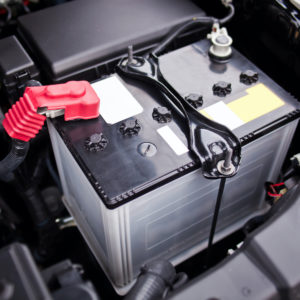So how long can a car battery sit unused?
Well, it depends on whether or not the battery is in a vehicle. A battery that isn’t in a vehicle will hold its charge a lot longer than if that same battery is in a newer vehicle with a lot of electronics.
Storing Your Vehicle
While planning on storing your vehicle, one of the first things you must consider is how long you can leave your battery unused. There is no exact answer that applies to all vehicles, but it should be okay to let your battery sit for less than three weeks.

Note that this rule of thumb isn’t universal. Some vehicles require one of the fuses to be removed for extended storage. Chryslers from the mid-1990s through the 2000s referred to this as the “ignition off draw” fuse (IOD). It’s well marked in the instrument panel or underhood fuse box. Some vehicles will have the IOD fuse(s) in a plastic cage so you can simply pull the cage to disengage the fuses and push it back to re-engage the fuses.
Others simply have the fuse marked and a place to put it in the panel while the vehicle is being stored. The IOD fuse typically disables accessories like the radio, along with the power seats, mirrors, and windows.
Most modern vehicles require power even while parked and their engine is off.
Your alarm system, electronic control settings, and evaporative emissions system will continue to draw battery power. Your vehicle may not start if you leave it parked for months with the battery connected.
If you have access to a power outlet, you can connect your battery to a trickle charger which will keep it topped up and prevent it from being drained completely.
But if you plan on storing your vehicle long-term and it doesn’t have an IOD fuse (check your owner’s manual to be sure), it’s better to disconnect the battery. This will preserve the battery’s charge, allowing your vehicle to start right back up once it’s reconnected.
Just keep in mind that you may need to reprogram things like your radio presets and seat memory buttons. It’s also important to drive your vehicle for a while before your next emissions test in order for the system to get a passing result.

How to Store a Car Battery
If you intend to keep your vehicle in long-term storage, you’ll need to make sure to do the following:
- Give it a full charge prior to storage
- Store it in a cool and dry location
- Put the battery on a battery maintainer
After taking your battery out of storage, inspecting the case for any signs of damage or leakage is important. Check the battery cable terminals for any corrosion that could cause poor contact and prevent proper charging and current flow. You should also look for the date of manufacture and consider it when deciding whether a battery replacement is necessary. With age, the battery’s capacity may be reduced which can cause slower-than-normal engine cranking.
Where to Find a Car Battery Replacement
If you don’t have a battery stored, and you find yourself in need of one, you can check out our extensive selection here at CarParts.com.
We offer high-quality car batteries sourced from reputable brands in the industry. Whether you drive a compact car, SUV, truck, or any other vehicle type, we have the perfect car battery for your ride.
To start, simply visit our website and use our vehicle selector to view compatible batteries. Then, use the search filters to find the ones that match your preferred brand, price, type, and series. Our catalog includes accurate and detailed fitment information, so you’re sure to get exactly what your car needs to get back on the road.
Our distribution centers are strategically located across the country, so expect your orders in as fast as a few days. Take a look at our selection now and order today!
Any information provided on this Website is for informational purposes only and is not intended to replace consultation with a professional mechanic. The accuracy and timeliness of the information may change from the time of publication.




















